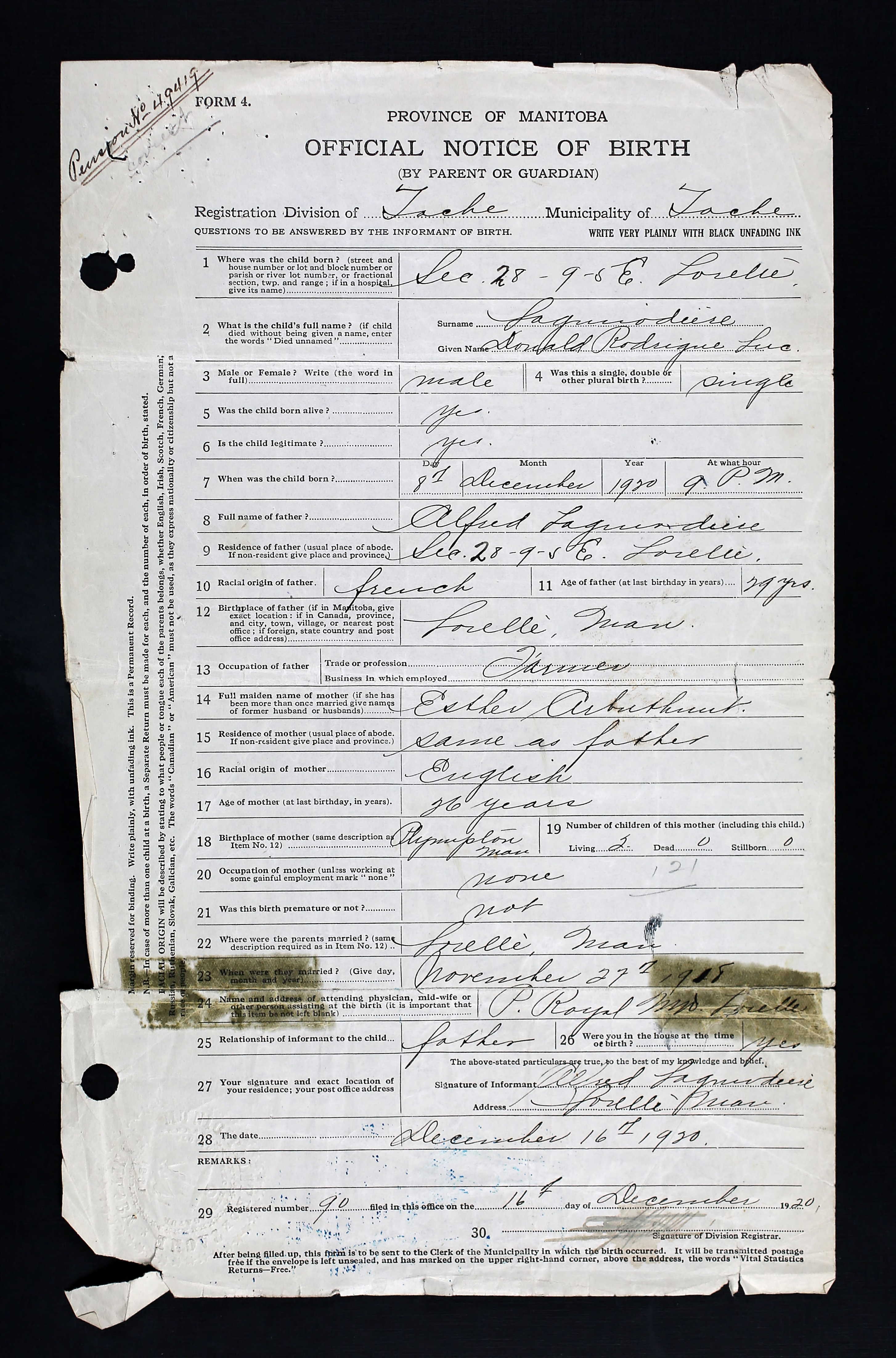
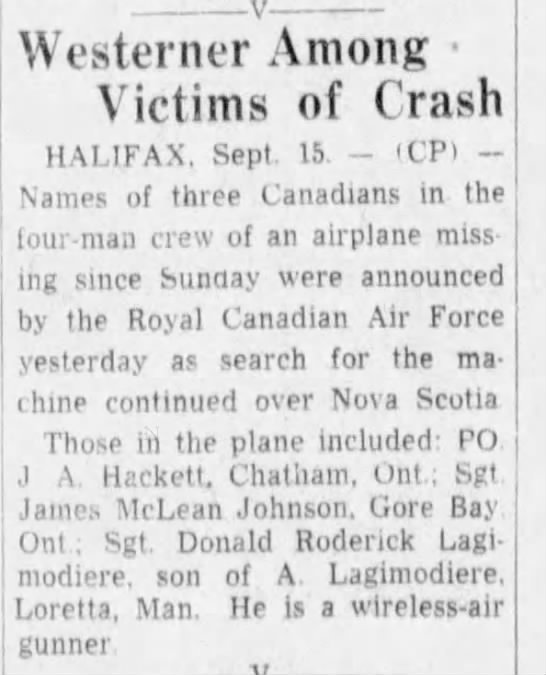
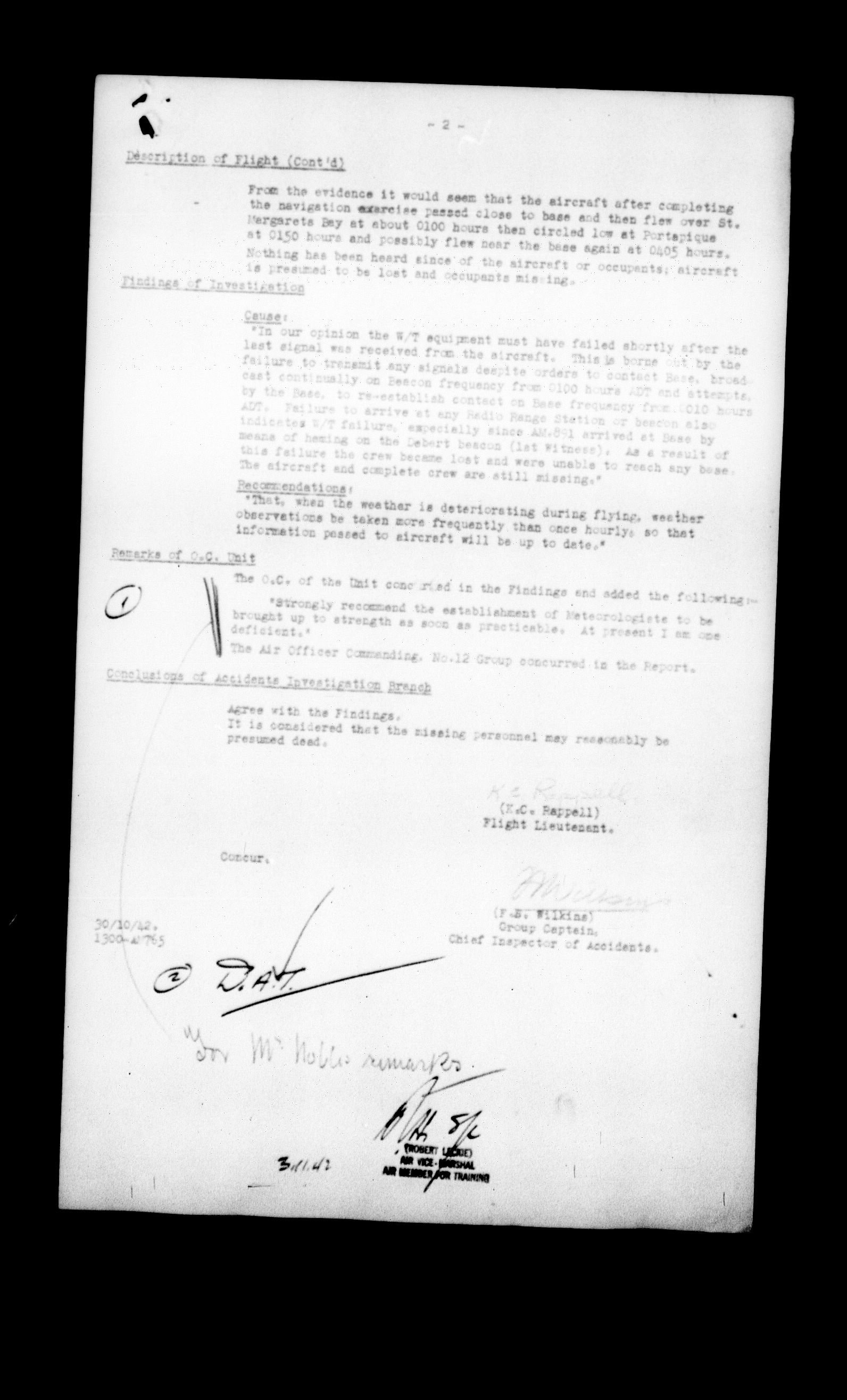

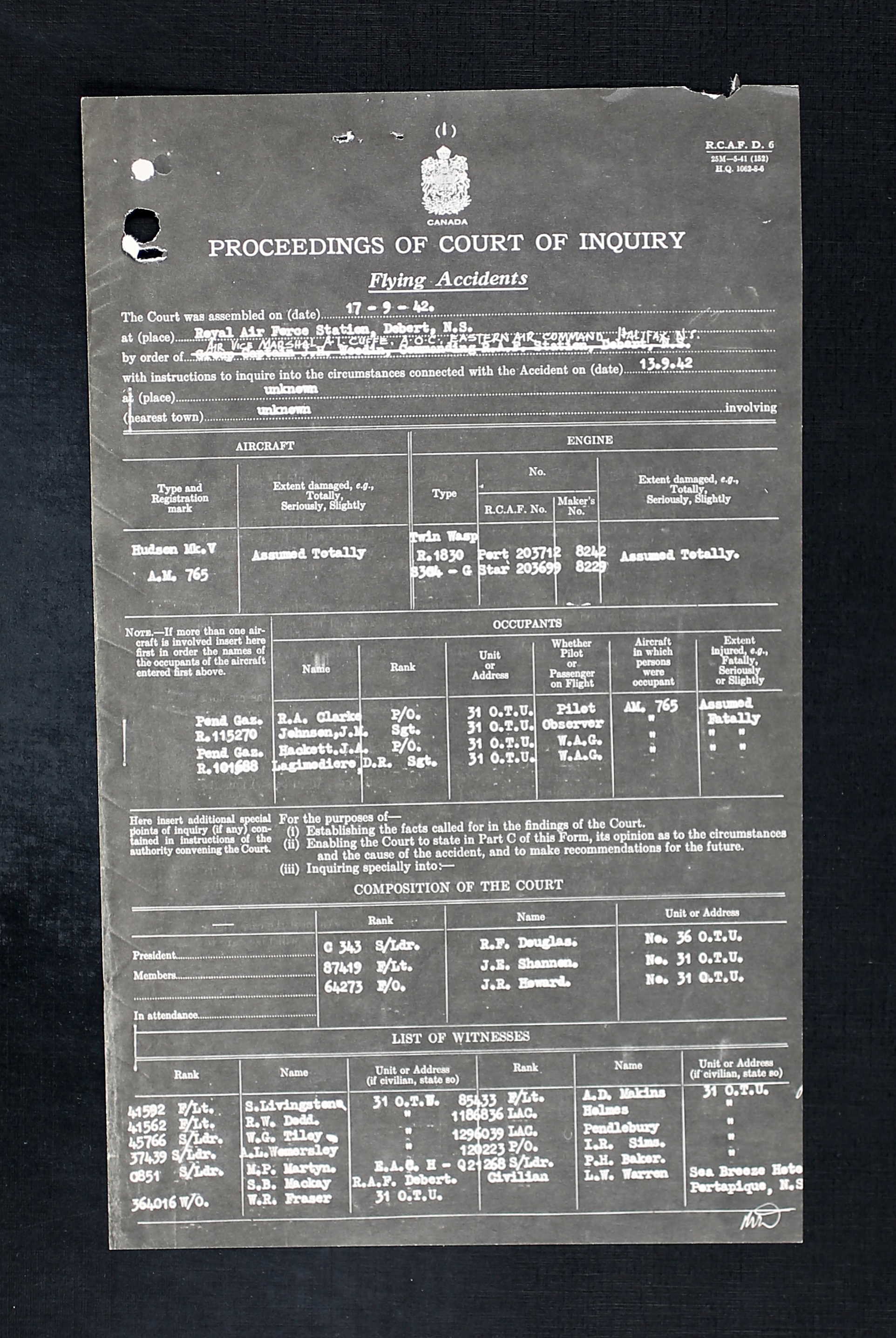
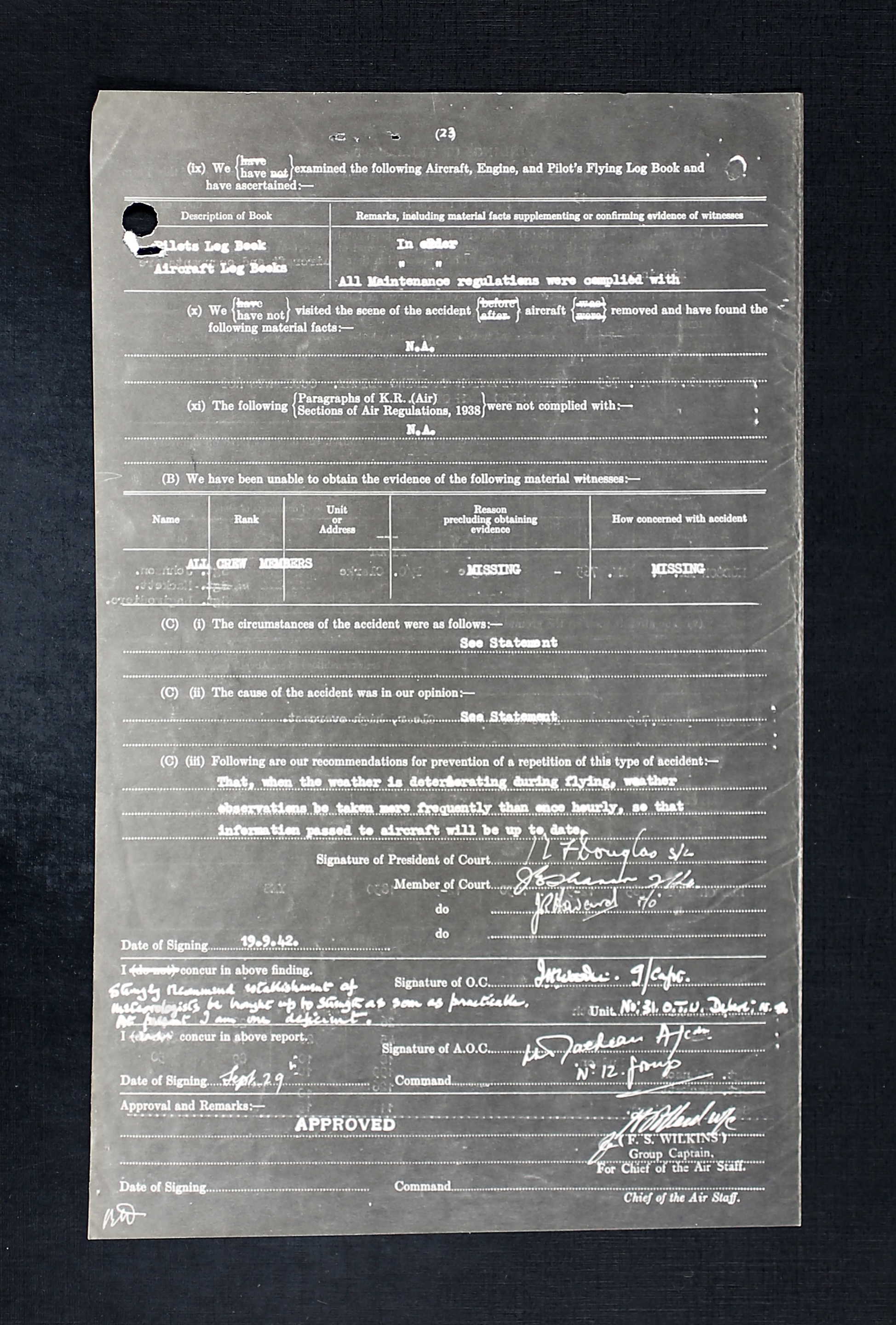
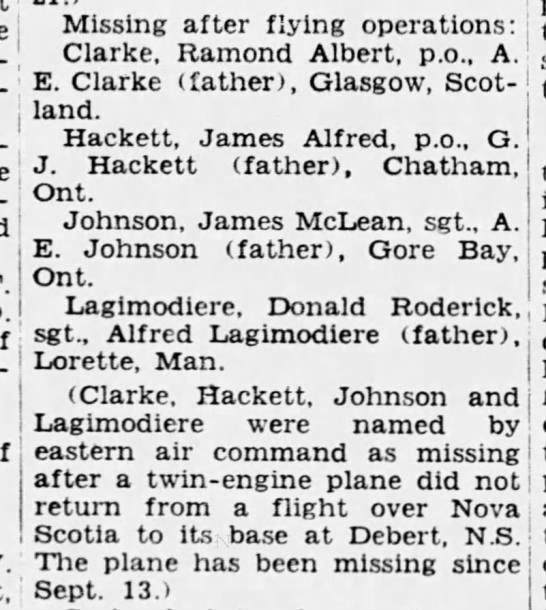
December 8, 1920 - September 13, 1942







Donald Rodrique Luc Lagimodiere was the son of Alfred Lagimodiere (1891-1959), farmer, and Hester [Esther] Margaret (nee Arbuthnot) Lagimodiere (1894-1987) of Lorette, Manitoba. He had three brothers, Norman (1926-2014), William (who was in the Canadian Army), and James, plus two sisters Marguerite (who was at Osbourne Barracks, Winnipeg) and Claudette. A third sister, Shirley May, died in September 1929 at the age of 2. The family was Roman Catholic.
Donald changed his name to Donald Roderick Lagimodiere. When his parents filled out the estates papers, they wrote his original name.
Donald liked hockey, bowling, tennis and shooting (target practice) his hobby. He was a bank teller. At some point, he broke his nose and fractured his left radius. He stood 5’9 ½” tall and weighed 149 pounds in April 1941. “Athletic. Mentally alert. Very find clean cut chap. Nice appearance and personality. Should make good aircrew.” He had brown eyes and dark brown hair.
Donald was fluently bilingual in English and French, as his father was of French Canadian heritage, his mother: Scotch Canadian.
Donald was a clerk then teller with the Royal Bank since 1937. He worked in four different locations in Manitoba until 1940: St. Boniface, Somerset, Shoal Lake, and Brandon before enlisting with the RCAF in April 1941. “I have driven automobiles, tractors, and worked with machinery.”
At ITS: “Alert, steady, hardworking type. 94th out of 146 in class. Possible commission with experience. 78%. Father served in last war. One brother in army.”
At No. 5 EFTS, High River, Alberta: “Careless, poor airmanship, heavy on controls. Slow thinker unsuited as service pilot. Accident: Overshot field, crashed fence on October 1, 1941. No injuries. Would like to be WOG or observer. Seems young. Doesn’t appear to realize responsibility of being a pilot. Good average type. Bright, not unduly put out at being washed out as pilot.” Donald was considered a low average pilot who had to be watched carefully. His progress had not been satisfactory and his flying training was discontinued. In ground school, he was inconsistent. “Lacks sense of responsibility but is keen. Judgment of height and distance poor. Blows up in tight spots. Would definitely not make a safe pilot. Conduct very good.”
Donald was sent to KTS, Trenton October 26, 1951 until he was remustered to No. 3 Wireless School, Winnipeg on November 22, 1941. He was at the station hospital from April 24-25, 1942.
He then went to No. 5 B&G, Dafoe, Manitoba May 10 to July 3, 1942.
On July 4, 1942, he was taken on strength at No. 31 O.T.U., Debert, Nova Scotia.
On a training flight aboard Hudson AM765 [details found on Microfiche C-5934, starting at image 5414] CREW: *P/O James Alfred Hackett, Chatham, Ontario, WAG, *Sgt James McLean Johnson, Gore Bay, Ontario, observer, *Sgt. Donald Roderick Lagimodiere, Lorette, Manitoba, WAG, and *P/O Raymond Albert Clarke, RAF, parents residing in Surrey, England, were lost on September 13, 1942. It was a night cross country, “Route 5.” The weather deteriorated as the flight continued.
From the Court of Inquiry: DESCRIPTION OF FLIGHT: On the night of the 12th of September 1942, P/O Clarke and P/O Hackett, Sgt. Johnson, and Sgt. Lagimediere [sic] were detailed on the night flying program to carry out a navigation exercise over Route 5 in aircraft Hudson AM765. At approximately 2010 hours, Hudson 765 took off with personnel as detailed. Soon after take-off, Hudson AM765 sent a message to station and the signals from the aircraft appeared quite normal. At 2324, Hudson AM 765 sent a message to base reporting all well, which was received at base. Strength 1, but with atmospherics 5. Other messages were received from the aircraft at 2330 hours and at 2345 hours. At 2355 hours, aircraft sent 3 position messages in Syko and then a request for QFE and QBB. Base replied to these messages. Both messages were received strength 4 and it was considered that the aircraft was twenty miles off base. Those were the last signals from the aircraft. At 0010 hours on 13/9/42, base called the aircraft by no reply was received and although base continued calling the aircraft until long after the endurance of the aircraft was finished, no further message was received from the aircraft AM765.”
There was no rain or drizzle before 0430 hours. At take-off: clear high overcast.
P/O Clarke’s flying time was noted on Tiger Moth, Anson and Hudson. Hudson: 18:10 hours dual and 89:50 solo.
It would seem that the aircraft after completing the navigation exercise passed close to base and then flew over St. Margaret’s Bay at about 0100 hours then circled low at Portapique at 0150 hours and possibly flew near the base again at 0405 hours. Nothing has been hear since of the aircraft of occupants. Aircraft is presumed to be lost and occupants missing.
CAUSE: In our opinion, the W/T equipment must have failed shortly after the last signal was received from the aircraft. This is borne out by the failure to transmit any signal despite orders to contact base, broadcast continually on Beacon frequency from 0100 hours and attempts by the base to re-establish contact at Base frequency from 0010 hours….RECOMMENDATIONS: That, when the weather is deteriorating during flying, weather observations be taken more frequently than once hourly so that information passed to aircraft will be up to date.” It was also recommended that the establishment of meteorologists to be brought up to strength as soon as practical. The station was one deficient.
In late October 1955, Mrs. Lagimodiere received a letter informing her that since Donald had no known grave, his name would appear on the Ottawa Memorial.